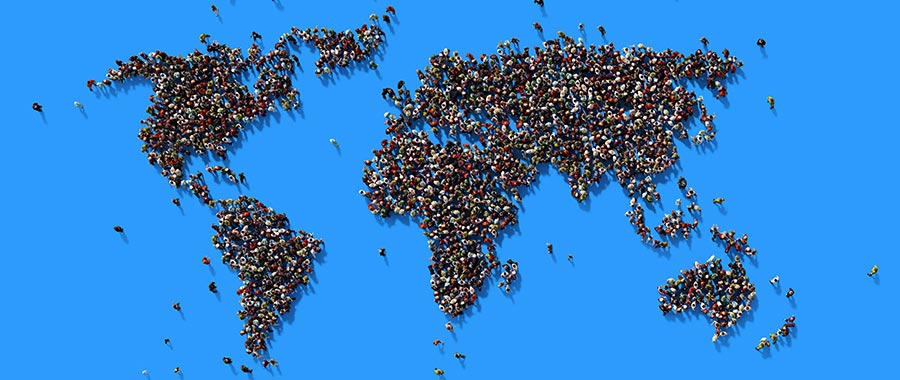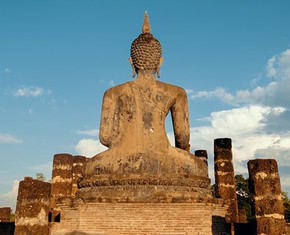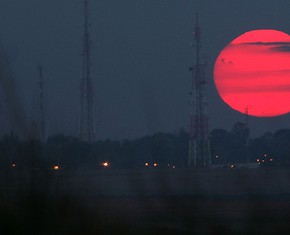The views expressed in our content reflect individual perspectives and do not represent the authoritative views of the Baha'i Faith.
The appearance of a true prophet is an Earth-changing event, revolutionizing the fortunes of humankind.
History has proven this true, time and again, even as we look at the vast number of followers of religion today, no matter the label. That massive recognition and acceptance of the prophet’s message happens gradually, over decades or even centuries and longer—yet the prophets in their own day are almost universally shunned and excoriated by the leaders and peoples of those places in which they proclaim their new cause. Many are tortured and martyred. Change comes hard, and belief in a new messenger of God comes harder still for members of existing religions or no religion.
The prophets do not come for our acclaim, or to be paraded down city streets and pronounced heroes. They come to suffer and atone for man’s inhumanity to man, thereby lifting all humankind to new levels of civility and civilization. They come when civilization and religion have declined. They come to revitalize the lagging fortunes of humanity.
Such was the case when Moses threw off the shackles of Egyptian royalty and became the savior of the enslaved Israelites. Shoghi Effendi, the Guardian of the Baha’i Faith, put it this way:
How often have the Prophets of God, not excepting Baha’u’llah Himself, chosen to appear, and deliver their Message in countries and amidst peoples and races, at a time when they were either fast declining, or had already touched the lowest depths of moral and spiritual degradation. – The Advent of Divine Justice, p. 17.
Rabbinic Judaism gives the dates of 1391 to 1271 BCE as Moses’ lifespan, and certainly at that time much of the world’s peoples were slaves, its citizenry cowed by armies who served the tyrannical leaders of the hour. The early Israelites had endured generations of slavery building grand treasure-cities, and were in a most degraded state. Redemption and freedom were prayed for but unthinkable. Then the great Lawgiver Moses appeared and led his people out of Egypt. However, biblical sources tell us they were still in a debauched and degraded state, resulting in a new generation born after wandering 40 years in the desert and finally reaching the Promised Land of Canaan.
So although Egypt was where the Prophet Moses appeared, it was not due to its greatness or people, or even to the Israelites themselves being exemplary. Quite the opposite.
The prophet Jesus Christ appeared from humble beginnings at the start of the first millennium. Christ revealed his station to the Jews, in the very same Canaan—the Holy Land—originally given them by Moses. Abdu’l-Baha explained it this way:
Moses and the prophets of Israel announced the advent of the Messiah but expressed it in the language of symbols. When Christ appeared, the Jews rejected Him, although they were expecting His manifestation and in their temples and synagogues were crying and lamenting, saying, “O God, hasten the coming of the Messiah!” Why did they deny Him when He announced Himself? Because they had followed ancestral forms and interpretations and were blind to the reality of Christ. They had not perceived the inner significances of the Holy Bible. – The Promulgation of Universal Peace, p. 198.
Notwithstanding the cries of the Jews for the Messiah, as a culture they had sunk to degeneracy and unbelief as well. Christ’s mission was to lift them up, as is the mission of all the prophets, but his example went mostly unheeded except for a few handfuls of devoted followers.
The story of the prophet Muhammad in Arabia, from the time his preaching beginning in 610 CE until his death in 632 CE, is a very similar one. At that time Arabia was governed by lawless, barbaric tribes, fighting and killing each other and stealing each other’s scarce resources. Caravans traversing the land had to pay protection or be decimated. Female babies were often buried alive or slaughtered as valueless in a male-dominated culture. Tribal vendettas were common. Yet Muhammad united these disparate tribes and his teachings created a great nation, with flowering arts, sciences and culture. Muhammad even signed pacts guaranteeing the safety of religious minorities such as Christians and Jews.
Repeating the exact same pattern, 1840’s Persia was sunk in the depths of religious oppression and fanaticism, where the clergy ruled as well as the Shah and his state-appointed ministers. It was a nation of corruption and lust for power and authority, religious and secular:
… of all the peoples and nations of the civilized world, that race and nation had, as so often depicted by Abdu’l-Baha, sunk to such ignominious depths, and manifested so great a perversity, as to find no parallel among its contemporaries. – The Advent of Divine Justice, p. 18.
Shoghi Effendi explained why the prophets manifest their new messages where and when they do:
To have appeared among a race or nation which by its intrinsic worth and high attainments seemed to warrant the inestimable privilege of being made the receptacle of such a Revelation would in the eyes of an unbelieving world greatly reduce the efficacy of that Message, and detract from the self-sufficiency of its omnipotent power. – Ibid.
So it is not because of any inherent high standards or admirable qualities that a prophet appears to a people, race or nation. It is precisely how that people changes, as reflected in the prophet’s teachings, that show the immutable purpose of God’s plan.
A look at the Baha’i Faith today, at its members and institutions, will prove both the Bab’s and Baha’u’llah’s transforming and creative power to change the hearts of men, women, children and youth. They are well-meaning, conscious and conscientious promoters of the wholeness and oneness of the human race, working towards the day when force will be the servant of justice, when love and respect will govern all human relationships.
















Comments
Sign in or create an account
Continue with Googleor